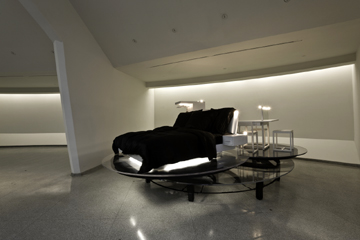
Spending the night in a museum is a childhood fantasy that would seem to better suit the crowded treasure troves of the Metropolitan Museum of Art than the more Spartan Guggenheim Museum. But when Carsten Höller’s Revolving Hotel Room went on sale as part of the museum’s current theanyspacewhatever show, it sold out within hours to the likes of Chloe Sevigny, New York magazine art critic Jerry Saltz, and dozens of others willing to pay between $259 and $799 for a night in the Guggenheim.And what did they get for their money? Besides the chance to settle in on a series of revolving circular platforms housing a bed, table and wardrobe, a guest and up to one companion per night received a private tour of the exhibition and the run of the place (more or less) from closing time to the next morning. The stage was set for a once-in-a-lifetime experience, so how did people take advantage of the opportunity?
Guggenheim press reps stress the privacy of the experience, but several participants wanted to share, including two members of a New Zealand family celebrating their birthdays who “skidded down the circular walkways in their socks.” Judging by the video they took, V Magazine bloggers Erin Krause and Greg Foley preferred to spend their time at their laptops, though their stay included a museum tour in their pj’s. Renowned bloggers Alaina Browne and partner Anil Dash checked in under the watchful eyes of BBC cameras, and London’s Sunday Times writer Susan D’Arcy recounted every detail and every amenity while reveling in her museum experience sans obnoxious hoi polloi. Sounds pretty mundane.
Thankfully, the always-enthusiastic Jerry Saltz also roamed the ramps in his pajamas but was more intent on having a transformative experience. After lying on the floors and standing in empty galleries, “paranoia set in” as he began to feel watched. After a bout of insomnia, he woke to find that the museum, “looked utterly new to me. I was in love with the place.”
One problem seemed to be the hermetic nature of the show, an encapsulation of the relational aesthetics aesthetic, which encourages audience participation but not always a great deal of visual stimuli. New York Times critic Roberta Smith applauded the Gugg’s “loosening up,” and jokingly suggested a new sign on the rotunda reading, “The Guggenheim Museum, Temporarily an Alternative Space, Inclusive and User-Friendly,” Time Out critic Howard Halle hit it on the head when he wrote, “Viewers can certainly be forgiven for wondering if the curators forgot to put up a show: the space looks half-empty, but it’s really just devoid of ideas.”
[youtube:https://www.youtube.com/watch?v=kWpUP0zrG54]
Overnighters needed to pack their own ideas, a concept reinforced by Philippe Parreno’s flashing marquee on the museum’s exterior, which either sets the museum up as a stage where anything can happen, or suggests that it’s just there for entertainment. Considering one of Höller’s past pieces, a series of slides installed at the Tate Modern last year, maybe the artist just wanted his audience to have fun – skidding in socks, etc.
Rising to the challenge of enduring or enjoying a night at the museum is tempered by the rules – only two guests can stay at any given time and a guard is always present at a distance. But Höller apparently intended his audience to think big – the piece is paired with a model of a proposed floating utopian community from 1928, which has been installed on the Guggenheim roof and viewed via live feed inside. The museum may itself be that peaceful utopia (for one night only), or Holler could be recruiting newly enlightened disciples to go forth into each cold morning with a new sense of place and possibility.
Were you one of the lucky ones? Post a comment if you stayed the night at the Guggenheim or have participated in a similar overnight in a museum.




Pingback: The Obamas arrive at the New Museum | Art21 Blog
Pingback: Top Billing at the Guggenheim | Art21 Blog
Pingback: Best of the Art21 Blog, 2008 edition | Art21 Blog